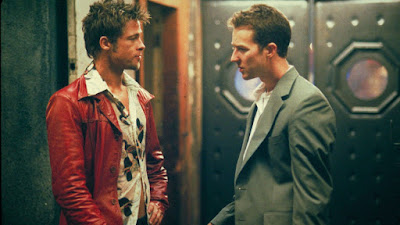Vertigo (1958)
After viewing Alfred Hitchcock's 1958 film Vertigo, I have a lot of thoughts. First of all, the average attention span in 1958 must have been much longer than mine. The two hour film consisted of probably about 20 minutes of James Stewart looking pensive in his detective hat as he drives around San Francisco. Nevertheless, despite the slow pace, Vertigo was an incredibly haunting and beautiful film that not only explores the idea of the doppelganger, but also dives into themes of sexuality, gender, and control. In the film, John Ferguson becomes infatuated with the mysterious, icy-blonde Madeleine, who he has been hired to follow due to her apparent psychosis and suicidal tendencies. According to her husband, Madeleine is supposedly possessed by a suicidal ancestor, Carlotta Valdes. Madeleine does seem to be haunted by some sort of force as she wanders around San Francisco, almost in some sort of trance. John rescues Madeleine after she flings herself into the Golden Bay in an attempt to kill herself. Then, there’s this extremely weird scene where it’s implied that John undressed Madeleine and put her in his own bed. When Madeleine wakes up she seems… fine with this? She even reciprocates John’s pervy flirtation, as if she didn’t just wake up naked in a stranger’s bed (who, by the way, is also 25 years her senior). Anyways, Madeleine and John enter into an affair after this, and the two seem to be falling in love. However, Madeleine is still haunted by Carlotta and experiences confusion and self-destructive episodes. Eventually, John takes Madeleine to the source of her fear, an old Spanish mission which haunts her dreams, to attempt to stop her nightmares. Here, Madeleine runs up the stairs of the steeple and throws herself off of the top floor, with John being unable to catch up to her due to his vertigo and fear of heights. John is devastated by Madeleine’s death, and after a year-long stay in a psychiatric hospital in a catatonic state, John is released into the real world again. He begins seeing Madeleine everywhere. Every woman seems to resemble her. After some time, he sees Judy, a dead-ringer for Madeleine, and follows her to her hotel (this guy is seriously creepy). Judy looks just like Madeleine in the face, but everything else is different. She is brunette instead of platinum blonde, her attire is much less sophisticated, and she is more sharp-tongued than the dazed, damsel-in-distress Madeleine. But, John sees Madeleine in her and asks her to dinner. Judy agrees and after John leaves, Judy reveals in a letter that she really is the woman John fell in love with, and she was hired by Madeleine’s husband to create a “witness” to Madeleine’s death, when in reality, Madeleine’s husband killed her. Judy rips up the note explaining all of this and decides to go to dinner with John, hoping he will learn to love her for who she is. Things are going pretty well for a while, until John starts to act strange. He wants to buy Judy new clothes, specifically clothes that Madeleine used to wear. He even asks her to dye her hair blonde, like Madeleine’s. The truth is, John was never in love with a real person. He was in love with a projection-- a fantasy of a person. Everything about Madeleine was dream-like. She always seemed to be enshrouded in a misty, golden light, she was soft-spoken and vulnerable due to her fragile mental state. She was the archetypal woman in John’s eyes who would fully submit to him and his masculinity. Judy’s hope that John would fall in love with her was truly hopeless, because John was obsessed with the illusion of perfection surrounding Madeleine. She existed entirely for him to fix his gaze upon. Madeleine’s main appeal to John was her sexuality and her need to be protected by him. Judy, by contrast, is a real woman with imperfections and is not simply defined by her beauty and submissiveness. John realizes this and gets to work “fixing” her. He wants her to not only resemble Madeleine, he wants her to be Madeleine, the perfect woman. He rather forcefully instructs her to change the way she dresses and her hair color, and Judy agrees because she so desperately loves him. After transforming her appearance to once again become Madeleine, John almost seems euphoric with happiness as he feels as though his perfect woman has come back from the dead. This, however, does not last long. As Judy is getting ready for a night out, she asks John to help her fasten her necklace. As he does so, he notices that it’s the same necklace that Madeleine had, and his world comes crashing down around him as he realizes that Madeleine and Judy are one in the same, and his perfect love never existed and could never exist.



Comments
Post a Comment